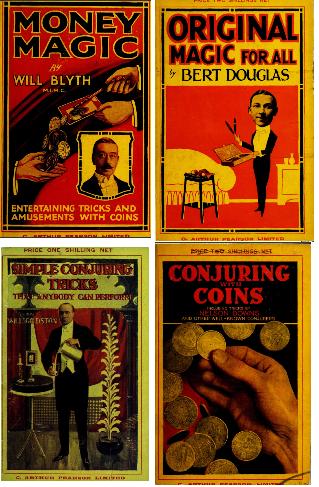Help us get to over 8,756 articles in 2024.
If you know of a magician not listed in MagicPedia, start a New Biography for them. Contact us at magicpediahelp@gmail.com
Yellow Perils
Yellow Perils was the term coined by Patrick Playfair to describe the bright yellow pictorial covered books produced by C. Arthur Pearson Ltd. of London in the early 1900s. Most of them were books on magic and other allied arts. Sir Cyril Arthur Pearson (1866 – 1921) was a British newspaper magnate and a prolific publisher who had no particular interest in magic, and in fact went blind by 1914, due to glaucoma. As an author he used many pseudonyms and wrote a number of instructional books on folkloric divination such as card-reading, and on puzzles, both under his own name and under the pseudonym Professor P.R.S. Foli.
Pearson's books on magic were originally very inexpensive, at only one shilling or two shillings a piece. Most of them had yellow card-stock covers over-printed in black and red. There was debate among magicians at the time as to whether they were offered for sale primarily to the public rather than to the magical community and were therefore to be considered exposures. Professional magicians started referring to them as "the yellow perils" — a term derived from the xenophobic 19th century metaphor used to depict peoples of East and Southeast Asia as an existential danger to the Western world — because their secrets were being made available so cheaply.
Raymond Ricard noted that there were 33 titles published in this series over a period of about 25 years, although not all were related to magic or the allied arts.
These books now are highly sought after by some collectors.
Titles [1]
- The Drawing Room Entertainer by Cecil H. Bullivant (1903)
- Magic Made Easy by David Devant (1903)
- After-Dinner Sleights and Pocket Tricks by C. Lang Neil (1904)
- Modern Card Manipulation by C. Lang Neil (1906)
- Tricks for Everyone by David Devant (1910)
- The New Book of Puzzles by C. Arthur Pearson (1911)
- Indoor Games for Children and Young People by E. M. Baker (1912)
- Simple Conjuring Tricks by Will Goldston (1913)
- The Complete Book of Hand Shadows by Louis Nikola (1913)
- Card Tricks without Sleight of Hand or Apparatus by L. Widdop (1914)
- Conjuring with Coins by T. Nelson Downs edited by Nathan Dean (1916)
- Pearson's Humorous Reciter (1918)
- Fun on the Billiard Table by Stancliffe (1919)
- Paper Magic by Will Blyth (1920)
- Chemical Magic by V. E. Johnson (1920)
- Match-Stick Magic by Will Blyth (1921)
- Ventriloquism and Juggling by Harold C. King & E. T. John (1921)
- Handkerchief Magic by Will Blyth (1922)
- Water Wizardry by Arthur Ainslie (1922)
- Have You Heard this One? by Charles Vivian (1922)
- More Paper Magic by Will Blyth (1923)
- Simplified Conjuring for All by Norman Hunter (1923)
- The Pearson Puzzle Book by by Mr X (1923)
- Impromptu Conjuring Without Apparatus by Will Blyth (1924)
- The Amateur Performer by W. J. Seymour (1924)
- My Mysteries by Ivor C. Smith (1924)
- New And Easy Magic by Norman Hunter (1925)
- Money Magic - Entertaining Tricks & Amusements with Coins by Will Blyth (1926)
- Original Magic for All by Bert Douglas (1927)
- Broadcast Conjuring Tricks by Cyril Shields (1930)
- The Best Tricks and How to Do Them by David Devant (1931)
- Pearson Puzzle Book by J. K. Benson
- Pearson's Book of Fun, Mirth & Mystery by Mr X
References
- Leat's Leaflets No. 2
- James Findlay "yellow perils" article for Magicol #29.
- ↑ Yellow Perils by Raymond Ricard in Perennial Mystics No. 16 (2001)
